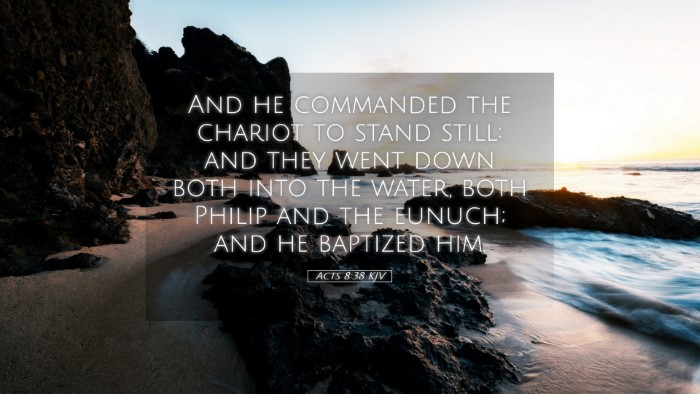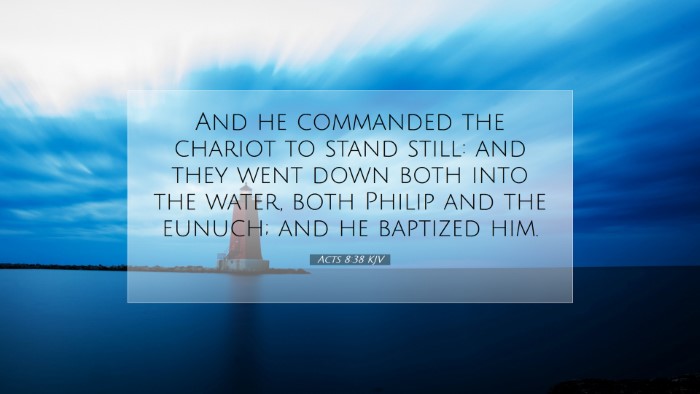Commentary on Acts 8:38
Verse: "And he commanded the chariot to stand still: and they went down both into the water, both Philip and the eunuch; and he baptized him."
Introduction
This verse captures a crucial moment in the early church’s mission, showcasing the significance of baptism as both an act of obedience and a public declaration of faith. The context here involves Philip, one of the seven deacons appointed in Acts 6, fulfilling his evangelistic calling by reaching out to the Ethiopian eunuch. This commentary synthesizes insights from various public domain theologians, providing a comprehensive understanding of its theological and practical implications.
Contextual Background
Philip's encounter with the eunuch is set against the backdrop of the early Christian church's expansion beyond Jewish communities. As the gospel moves into Samaria and beyond, it underlines the universal offer of salvation through Christ. The Ethiopian eunuch, a high official in charge of the treasury of the queen of the Ethiopians, symbolizes the inclusion of Gentiles into the faith.
Matthew Henry's Insights
Matthew Henry emphasizes the importance of the Ethiopian eunuch's journey towards faith. He notes that God orchestrated Philip’s divine appointment to meet the eunuch at the right moment. According to Henry, the eunuch's earnest desire to understand Scripture (referring to Isaiah) reflects the Holy Spirit's work in drawing individuals to Christ.
Albert Barnes's Perspective
Albert Barnes elaborates on the significance of baptism in the early church, stating that it serves as an outward sign of an inward transformation. He asserts that the act of baptism illustrates obedience to Christ’s command and the reception of the Holy Spirit. Barnes highlights that this episode underscores the inclusivity of the gospel message, evidencing that no one is too far removed from God’s grace.
Adam Clarke’s Commentary
Adam Clarke provides a detailed exegesis on the act of baptism performed by Philip. He notes that the physical act of going into the water signifies the humility and seriousness with which the eunuch approached his newfound faith. Clarke stresses that baptism should be viewed as a commitment to a new life, not merely a ritualistic practice. Moreover, he points out the importance of the eunuch’s willingness to be baptized, which illustrates a personal confession of faith.
Theological Implications
This verse conveys profound theological themes. The act of baptism represents several critical elements within Christian doctrine:
- Obedience to Christ: Philip’s immediate response to the eunuch's query about baptism demonstrates the urgency of obeying the Great Commission (Matthew 28:19-20).
- Faith and Repentance: The eunuch’s request for baptism implies a prior understanding and acceptance of the gospel message, a requirement paired with repentance as mentioned in Acts 2:38.
- Unity in Diversity: The inclusion of a Gentile highlights that the gospel transcends cultural and ethnic boundaries, fulfilling the promise given to Abraham that all nations will be blessed (Genesis 12:3).
Practical Applications
The narrative surrounding Acts 8:38 serves as a model for contemporary baptismal practices and evangelism:
- Immediate Response: Just as Philip acted without hesitation upon the eunuch's request, modern believers are encouraged to respond promptly to opportunities for sharing the gospel.
- Personal Engagement: Philip's willingness to engage deeply with the eunuch’s questions illustrates the need for relational evangelism, where believers meet individuals at their point of need.
- Public Declaration: Baptism is not merely a private affair but a public proclamation of faith. Churches should encourage believers to publicly testify to their faith journey through baptism.
Conclusion
Acts 8:38 is not only a historical account but a rich source of theological reflection and practical guidance for the church today. The insights drawn from Matthew Henry, Albert Barnes, and Adam Clarke pull together a comprehensive understanding of baptism's role in the life of a believer. It encourages a posture of readiness to engage with others about faith while exemplifying the reality of transformation through the public declaration of believer’s baptism.


